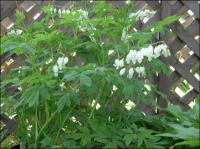Description
May – June Legendary dangling alabaster, heart shaped blossoms. One of the best.
Dangling alabaster, heart shaped blossoms
May – June Legendary dangling alabaster, heart shaped blossoms. One of the best.
“…the berries are the thing – pewter in color, with a texture like those Fourth of July sparklers of childhood memory, they have a delicious fragrance.” Allen Lacy.
Size: 9’ x 10’
Care: sun in any soil
Native: Canada to Southeastern U.S. No pruning needed but can be pruned at any time of year, if desired.
Wildlife Value: Berries relished by chickadees, red-bellied woodpeckers, swallows, Titmouse, catbirds, bluebirds, Northern flicker & yellow-rumped warblers. Bayberry thickets also provide nesting sites for songbirds, offering excellent protection from predators.
Size: Fragrant leaves used for potpourri, abundant berries used to make candles. Good road-side plant, salt tolerant.
Probably 1st collected for gardens by John Bartram (1699-1776). Offered for sale in Bartram Garden’s 1783 Broadside, America’s 1st plant catalog. In 1800’s considered “very ornamental in the shrubbery.”
**LISTED AS OUT OF STOCK BECAUSE WE DO NOT SHIP THIS ITEM. IT IS AVAILABLE FOR PURCHASE AT OUR RETAIL LOCATION.
OUT OF STOCK
White-lavender flowers in May atop wiry stems look like fantastical birds with too many wings, or a four-cornered bishop’s hat. Ornamental heart-shaped leaves and red stems.
Size: 6-12” x 18” slow spreader
Care: shade to part shade in well-drained to moist well-drained soil. Once roots established, valuable in dry shade
Native: China, Japan & Korea
Its Chinese name is “Yin Yang Ho” meaning “Licentious goat herb, “ because allegedly an aphrodisiac for goats! In China & Japan thought to remedy impotence, liver ailments & all age related maladies. In Western gardens since 1834.
OUT OF STOCK
Purple, upfacing bells for months in mid to late summer
Size: 4-6” x 20”
Care: full sun-part shade in moist well-drained soil
Native: Northern Yugoslavia
Awards: England’s Royal Horticultural Society Award of Merit. Top rated for ornamental traits and landscape performance by the Chicago Botanic Garden & Elisabeth Carey Miller Botanical Garden Great Plant Pick.
Campanula is Latin meaning “little bell.” This species named for one of its discoverers, Franz Edler von Portenschlag-Ledermayer (1772-1822). 1st described in Systema Vegetabilium 5: 93 in 1819
OUT OF STOCK
Lavender-Pink outside and white inside funnels in June
Size: 20” x 12-24”
Care: sun in well-drained soil
Native: northeast North America
Wildlife Value: feeds native bees, Baltimore butterfly and endangered Rusty patched Bumble Bee
Penstemon is named for its five stamens, penta meaning “five” and stemon meaning “stamen” in Greek. Penstemons are “handsome and deserving,” Bailey. P. hirsutus sent from America to England in 1758.

